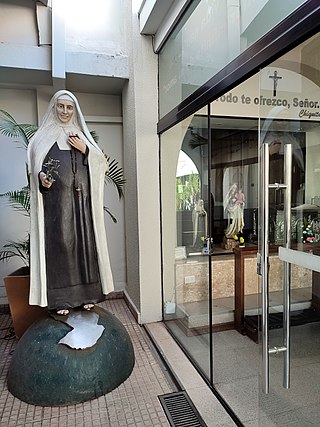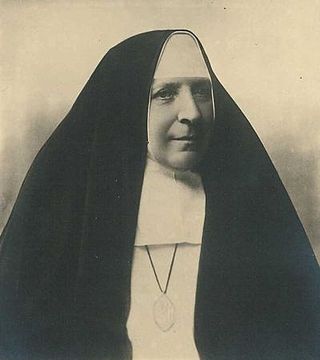Related Research Articles
Maria Orsola Bussone was an Italian Roman Catholic and a member from the Focolare Movement. Bussone's involvement in her adolescence in parish activities led her to Catholic Action as well as to other movements that she served as an active participant; she learnt the guitar and liked sports and music which she engaged in with her close friends. But those who knew her attested to her deep spiritual desires which she found sated in the Focolore Movement that she first came into contact with in the late 1960s. Bussone desired to act as a vessel for the goodness of God and desired that He would "…use me as He wants". Bussone died in an accident in 1970 and there were immediate calls to launch a process for beatification due to the impact she had made on local communities.

Cecilia Eusepi was an Italian Roman Catholic and a professed member from the Secular Servites. Eusepi died of tuberculosis at 18 years of age, but only after her confessor advised her to keep a journal of her own life, which she titled Storia di un Pagliaccio, for she considered herself to be a "little clown" and "a half-stupid clown good for nothing"; she wrote that it must be her extreme weakness that appealed to God.
Giuseppina Gabriela Bonino, also known by her religious name Giuseppina Gabriella of Jesus, was an Italian Roman Catholic professed religious and the founder of the Suore della Sacra Famiglia di Savigliano. Bonino dedicated her life to the ill and to orphans and did this in drawing upon her own experience in tending to her ailing father and to orphans in her hometown - all this prior to and after the establishment of her religious congregation.

Maria Domenica Mantovani was an Italian Roman Catholic professed religious, and the co-founder of the Little Sisters of the Holy Family; she established them alongside Giuseppe Nascimbeni. As a nun she received the religious name of Maria of the Immaculate.
Giuseppina Nicoli was an Italian Roman Catholic religious sister. Nicoli - aged 20 at the time - became a member of the Vincentians and became a catechist in Sardinia where she was positioned for most of her life despite holding several positions of leadership in Turin and elsewhere for a brief period.

Blessed Maria Pia Mastena - born Teresa Maria - was an Italian religious sister in the Roman Catholic Church. She was the founder of the Religious Sisters of the Holy Face. Mastena fostered a deep devotion to the Holy Face of Jesus and tried to promote that devotion to others in her religious career as a nun. Mastena first desired the contemplative life but was denied this after she entered the convent since it was not a cloister. Instead she dedicated herself to teaching in several Italian cities after having left another convent and another religious order when she deemed contemplative life was not the life she felt God wanted for her. Her labors were dedicated instead to consolidating a new religious congregation which began to grow after World War II until Mastena's sudden death in 1951. Mastena was beatified on 13 November 2005.

María Guadalupe García Zavala – born Anastasia Guadalupe García Zavala – was a Mexican Roman Catholic religious sister and the co-founder of the Handmaids of Santa Margherita and the Poor. She is also known as "Mother Lupita". At one time, she was engaged to be married but she decided her religious call was too strong for that and she broke off her engagement in order to pursue this call. She dedicated herself to the care of ill people and was noted for her compassion and faith.
Giovannina Franchi was an Italian Roman Catholic professed religious and the founder of the Suore Infermiere dell'Addolorata. Franchi was engaged for a brief period of time and the death of her fiancé prompted her to review her life and what her religious convictions were telling her to do; she had been involved in countless charitable works in the past and so dedicated herself to the care of the ill. Her order became tasked with aiding the ill across Como and the smallpox epidemic in 1871 thrust them into action later claimed Franchi's life.

Assunta Marchetti was an Italian Roman Catholic religious sister and the co-founder of the Missionary Sisters of Saint Charles Borromeo Scalabrinians; she worked in Brazil from 1895 until her death. She has been beatified as a Blessed Mother. Her priest brother Giuseppe is titled as Venerable on the path to sainthood.

Caterina Dominici was an Italian Roman Catholic nun who took the name of Maria Enrichetta after she became a nun of the Sisters of Saint Anne. During the 1854 Broad Street cholera outbreak she cared for and ministered to countless people. She then went on to serve for over three decades as the Superior General of her congregation. She was also a friend and adviser to John Bosco.

Giuditta Vannini – also known as Giuseppina – was an Italian Roman Catholic nun who became a Camillian. Together with Luigi Tezza she established the religious congregation known as the Daughters of Saint Camillus. She and her two siblings were orphaned as children and were placed in different homes; she was raised and educated in Rome under nuns where her vocation to the religious life was strengthened. Vannini later tried joining a religious order but was forced to leave during her novitiate period after suffering from ill health. She and Tezza met in 1891 and founded a religious congregation of which Vannini served as Superior General until her death while Tezza was exiled to Peru around 1900.

Clotilde Micheli was an Italian Roman Catholic professed religious who established the order known as the Sisters of Angels; she assumed the religious name Maria Serafina of the Sacred Heart upon the order's foundation and her profession into it. She had once before been part of a religious order in which she received the name Maria Annunziata but discarded it when she left their ranks.

Eugenia Maria Ravasco was an Italian Roman Catholic nun of the Ravasco Institute that she herself had established - the order was also known as the Daughters of the Sacred Hearts of Jesus and Mary and was founded in the Archdiocese of Genoa where she spent most of her life.

Hendrina Stenmanns, SSpS was a German Catholic religious sister who co-founded the Missionary Sisters Servants of the Holy Spirit, which she founded alongside Arnold Janssen and Helena Stollenwerk. She was also a professed member of the Third Order of Saint Francis since 1871.

Alphonse-Marie Eppinger, SDR; 9 September 1814 – 31 July 1867), born Elisabeth Eppinger, was a French Catholic nun and the founder of the Sisters of the Divine Redeemer.

María Guggiari Echeverría, OCD, was a Paraguayan Discalced Carmelite who served in her adolescence as a member of Catholic Action. Echeverría entered the Carmelite order despite the opposition of her parents.

Arsenio da Trigolo, OFM Cap., was an Italian Catholic priest and a professed member from the Order of Friars Minor Capuchin.

Clara Fey was a German Roman Catholic Nun and the founder of the Sisters of the Poor Child Jesus. Her life was dedicated to providing aid to the poor, with particular emphasis on education, first in Aachen and later in the Netherlands.
Gaetana Tolomeo - also known as Nuccia - was an Italian Roman Catholic. Tolomeo went through her entire life either confined to her bed or in a chair due to a progressive paralysis that rendered her disabled. Throughout her life she gained a reputation for her piousness and the messages of the Gospel she sought to spread to others while a guest on a local radio station from 1994 until her death. Her time on the radio station marked her interest in reaching out for the conversion of sinners with an emphasis on reaching out to prostitutes or families in need.
Vincenzina Cusmano was an Italian Roman Catholic professed religious from the Sisters Servants of the Poor. Her brother was Giacomo Cusmano; she joined his religious congregation as the two tended to the poor in Palermo. Her original intention was to become a cloistered Carmelite nun though was forced to abandon this desire after her mother died; her mother's death during an epidemic meant that she had to assume care for her siblings since she was the eldest one. Cusmano tended to the poor in Palermo and often worked alongside her brother in this venture until his death in 1888; she continued his work as the Superior General for her order until her own death.